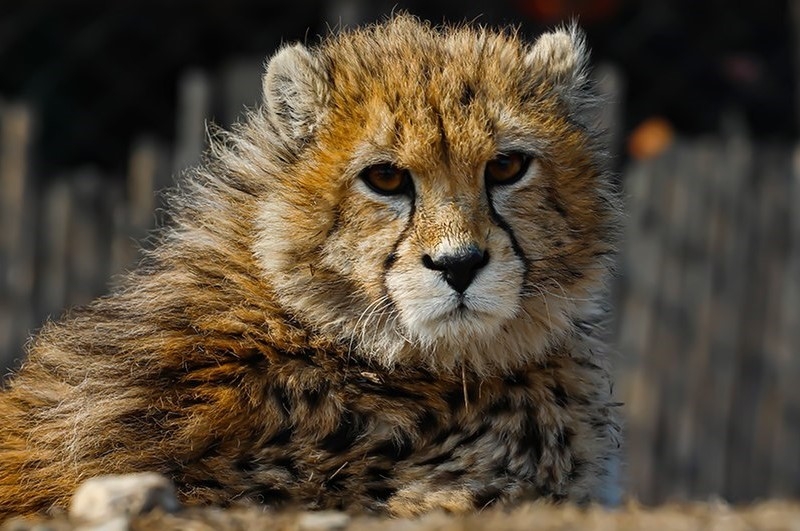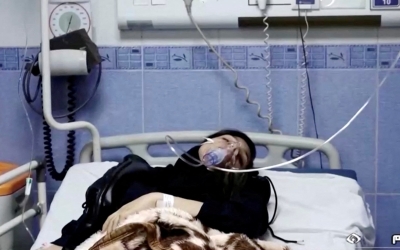Iran: Death of rare Asiatic cheetah cub highlights country’s environmental woes

The death of a rare animal species in Iran has provoked an outcry from the public and shined a spotlight on the government’s inability to preserve the nation’s wildlife and biodiversity.
Pirouz was the only survivor of three critically endangered Asiatic cheetah cubs born last May who died on 28 February at a veterinary hospital in Tehran as a result of kidney failure.
The three cubs were born in captivity via a caesarean section operation, but his siblings didn’t survive after their mother - named “Iran” - rejected them.
The authorities had pinned their hopes on protecting Pirouz so that the subspecies, which is facing extinction, would reproduce.
In 2010, an estimated 100 wild Asiatic cheetahs lived in Iran, but their number has plummeted to only a dozen today.
New MEE newsletter: Jerusalem Dispatch
Sign up to get the latest insights and analysis on Israel-Palestine, alongside Turkey Unpacked and other MEE newsletters
According to the International Society for Endangered Cats (ISEC), the Asiatic cheetahs that once inhabited the grasslands of Iran, India, Pakistan, Russia, and parts of the Middle East and Africa have been eliminated because of a combination of factors, including “excessive hunting, habitat degradation and scarcity of prey species”.
'Victorious'
Pirouz, which means “victorious” in Persian, had become an icon of hope and national pride among Iranians who revelled in the exceptional speed and intelligence of the animal, believed to be the world’s fastest mammal.
Also, his name resonated with many of those involved in the anti-government protests that emerged following the death in custody of Kurdish woman Mahsa Amini.
The song Baraye by singer Shervin Hajipou, which became the unofficial anthem of the protests, references Pirouz's plight.
For many Iranians, the rare cheetah was emblematic of the nation’s environmental gifts and once-thriving wildlife.
But his death, which experts ascribed to poor living conditions and the absence of the equipment needed to treat him, redirected attention onto the government’s failure to invest in environmental protection and its lack of safeguards for the natural world.
'The way that Pirooz was dealt with is exactly the same way that other elements of our environment, water, lands and air and other species are taken care of in Iran'
- Ali Nazemi, academic
Pirouz had suffered from digestive problems since birth, but his complications escalated, and he refused to eat and drink for several consecutive days.
He was hospitalised at a Tehran veterinary clinic on 23 February where it was decided that he needed dialysis.
He eventually died five days later.
His death inspired an outpouring of grief on social media by users who had been following his health closely.
Local reporters said the special hemodialysis machine needed for treating animals didn't exist in Iran, and that the government refused offers from affluent members of the diaspora who reached out to express their readiness to send the equipment and associated medication to Iran.
“The objection that can be directed at the Department of Environment is that Pirouz was supposed to undergo a check-up at the age of eight months, but they didn’t carry out the checks.
"There were officials at the department who feared that if the animal was to be anaesthetised, he might face fatal threats and be never revived, and they possibly dreaded the public uproar,” said Zeinab Rahimi, an environmental journalist in Iran, speaking to Middle East Eye.
“The necessary check-up was not done, and we saw that Pirouz didn’t get to the age of 10 months."
Departmental criticism
According to Rahimi, the Department of Environment had been under critical scrutiny way before Pirouz died, starting with the pregnancy of the animal's mother, Iran, and her delivery, which was facilitated through cesarean section.
Rahimi says the authorities, who did not have a vet with knowledge of birthing cheetahs, could have asked for external assistance, including by inviting experts from South Africa, where such expertise is available, and from where a specialist was eventually invited after Iran’s delivery in order to conduct the postpartum ultrasound scan.
An environmental activist and conservationist were assigned to be Pirouz’s caregivers shortly after his birth and after his two other siblings died prematurely.
Alireza Shahrdari spent extensive amounts of time with Pirouz at the Pardisan Park, where the cheetah cub was taken after he was born in the Touran wildlife refuge in the Semnan Province.
Shahrdari would sleep next to Pirouz at night and provided regular social media updates on his health to an enthusiastic public.
His Instagram story announcing the loss of the popular cub generated widespread agony that quickly evolved into anger with people blaming the government for its environmental mismanagement.
Video posted by Alireza Shahrdari shows him sleeping next to Pirouz at night to help him keep warm
“The death of Pirooz [sic] signified how naiveness, unpreparedness, and arrogant environmental management can result in catastrophic events and lead to the emergence of tragedies," said Ali Nazemi, a water expert and associate professor at the Department of Building, Civil and Environmental Engineering at Concordia University.
"In addition, it showed once again that after such tragedies, no one is responsible, and accountability is rather non-existent.
“The way that Pirouz was dealt with is exactly the same way that other elements of our environment, water, lands, and air, and other species are taken care of in Iran,” he told MEE.
Environmental crises
Iran has been grappling with a myriad of environmental crises, including the desiccation of Lake Urmi, which is the largest saltwater lake in the Middle East, alongside endemic deforestation, rampant pollution on the coasts of the Caspian Sea, sandstorms in the Khuzestan Province, and the rapid shrinking of drinking water resources.
The dominant public perception is that the government doesn’t see any value in protecting the environment and responding to these challenges.
Experts believe the funds allocated to the Department of Environment to tackle this melange of cataclysms are nowhere near sufficient, and the government is instead ploughing money into institutions that are tasked with producing ideological propaganda, such as the religious seminaries, and state TV.
President Ebrahim Raisi recently submitted the 2023 budget bill for consideration by Iranian lawmakers.
The share given to the Department of Environment is a trifling $72.8m, which constitutes a tiny 0.2 percent of the total annual budget.
Government funding is the Department of Environment's only source of revenue.
In the Global Biodiversity Index 2022 compiled by The Swiftest data analytics, Iran is ranked 48th out of 201 countries and territories in terms of the number of bird, amphibian, fish, mammal, reptile, and plant species.
The Asiatic cheetah is believed to be only found in Iran today.
This article is available in French on Middle East Eye French edition.
Middle East Eye delivers independent and unrivalled coverage and analysis of the Middle East, North Africa and beyond. To learn more about republishing this content and the associated fees, please fill out this form. More about MEE can be found here.





